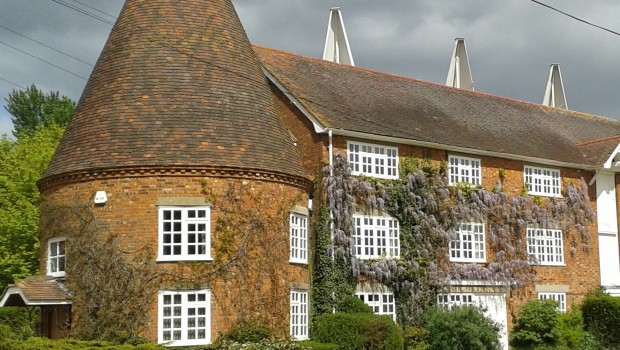Oast Houses – A Brief History
by John Flashman
Oast houses are of course a distinctive feature of the Kent and Sussex landscape. They are also found, to a lesser degree, in Surrey, Hampshire, Herefordshire and Worcestershire. They were constructed originally to dry the harvested mature hops for use as an ingredient in brewing beer but nowadays hops are dried in modern ridge ventilated buildings and only a very few working oasts remain, one example being at Little Scotney Farm, Lamberhurst, on the Scotney Castle estate which is owned by the National Trust.
The word ‘oast’ itself seems to derive originally from the Latin word ‘aestus’ meaning ‘burning heat’. In Anglo-Saxon times the word ‘ast’ meant any sort of kiln but by the 16th century the term ‘ost’ (or alternatively ‘oste’, ‘oost’ or ‘oust’) was used to refer to a kiln used to dry either malt or hops, the latter having been introduced into England in the mid 16th century. But by the 19th century ‘oast’ had become universally adopted as referring specifically to a kiln used to dry hops. However, the Kentish dialect word ‘kell’ also was used for kilns as in “the oast has three kells” and sometimes to mean the oast itself.
Records show that the first form of oast house appeared around the latter part of the 1500s, with the increasing use of hops as a profitable crop. It was not however until the mid 1700’s that hop production took off and oast houses came to be built in greater numbers. By the mid 1800’s it was in full production and many of the oast houses that can be seen today originated from that time. Over 5,000 oast houses were constructed in that era, with 3000 in Kent alone.
Early oast houses were no more than adapted barns but, by the 18th century, the distinctive tall buildings with conical roofs had been developed to increase the draught. At first these were square but around 1800 roundel kilns were developed in the belief that they were more efficient. Square kilns remained more popular in Herefordshire and Worcestershire and came back into fashion in the south east in the later 19th century. In the 1930s, the cowls were replaced by louvred openings as electric fans and diesel oil ovens were employed.
The earliest surviving purpose built oast house in Kent appears to be the Grade II listed Godwin House oast at Little Golford, near Cranbrook. Thought to have been built around 1740 it is a small timber framed building with one kiln and a single cowl in the ridge of the hipped tile roof. It is perhaps worth mentioning that Cranbrook and the neighbouring parishes of Sissinghurst and Benenden have most of the oldest Kent oast houses built from the mid-1700s.
A summary of how oast houses were traditionally used can be seen in the 1926 edition of the Encyclopedia Britannica: “After being picked, the hops are taken in pokes – long sacks holding ten bushels – to the oasts to be dried. The oasts are circular or square kilns, or groups of kilns, wherein the green hops are laid upon floors covered with horsehair, under which are enclosed or open stoves or furnaces. The heat from these is evenly distributed among the hops above by draughts below and around them. The hops are from nine to ten hours drying, after which they are taken off the kiln and allowed to cool somewhat, and are then packed tightly into ‘pockets’ 6 feet long and 2 feet wide, weighing 1.5 hundredweight, by means of a hop pressing machine which has cogs and wheels worked by hand.” In passing it should be noted that by using this traditional kiln method the moisture content of the hops was reduced from 80% to the required level of 10%. An additional point to make is that the drying floors were deliberately thin and perforated in order to permit the heat to pass through and escape through a cowl in the roof which turned with the wind.
Inevitably with the passage of time the hop-picking process became modernised and from the 1960s onwards many oast houses fell into disuse. Some were demolished, some became used for storage of fruit and farm machinery and some were left simply to decay. However, in the 1970s, and the 1980s in particular, the demand for increased housing meant that the conversion of oasts to homes in the south east became widespread. Stylish residences, often with round reception rooms, became a desirable feature of the property market. The older oasts often became listed buildings and whilst most internal fixtures and structures disappeared the typical external format of oast, kiln and cowl has been widely preserved.
One of the best preserved oast house complexes is at the Hop Farm Country Park at Beltring, just outside Paddock Wood. Part of this complex was Brookers Oast which was built in the mid-1800s and was last used for drying hops in 1948. In 1982 when the hop farm was opened as a tourist and education facility, Brookers Oast became a working craft centre. In 1991 it was fully converted into a bar and restaurant. When the entire hop farm tourist complex was offered for sale in 1997, Brookers Oast was not included and remains part of the Brewers Fayre restaurant chain.
Other conversions of oasts for non-residential purposes include theatres at Tonbridge and Rainham; a visitor centre at Ide Hill; Bower Grove School, Maidstone; Steiner School, Canterbury; a health centre at Barming; a Christian Retreat Centre at Northiam; and the Museum of Kent Life at Sandling to name but a few.
Acknowledgements to Meryl Flashman; Carol Prier; Robin and Ivan Walton






Comments